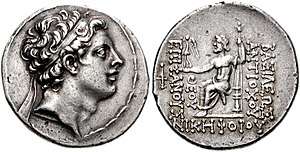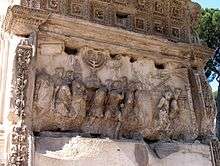Abomination of desolation
"Abomination of desolation" is a phrase from the Book of Daniel describing the pagan sacrifices with which the 2nd century BCE Greek king Antiochus IV replaced the twice-daily offering in the Jewish temple, or alternatively the altar on which such offerings were made.[1] in the 1st century CE it was taken up by the authors of the gospels in the context of the Roman destruction of Jerusalem and the temple in the year 70,[2] with Mark giving Jesus a speech concerning the Second Coming,[3] Matthew 24:15-16 adding a reference to Daniel,[4] and Luke Luke 21:20-21 giving a description of the Roman armies ("But when you see Jerusalem surrounded by armies..."); in all three it is likely that the authors had in mind a future eschatological (i.e., end-time) event, and perhaps the activities of some anti-Christ.[5]
.jpg)
Book of Daniel

The Book of Daniel originated as a set of folktales among the Jewish community in the late 4th to early 3rd centuries BCE.[6] At that time a lamb was sacrificed twice daily, morning and evening, on the altar of the Jewish temple in Jerusalem, but Antiochus IV, the king of the Greek Seleucid dynasty which then ruled Palestine, put an end to it in 167 BCE.[7][8] The visionary chapters of Daniel, chapters 7-12, were added to the Book of Daniel at this time in order to reassure Jews that they would survive in the face of this threat.[9] In Daniel 8 one angel asks another how long "the transgression that makes desolate" will last; Daniel 9 tells of "the prince who is to come" who "shall make sacrifice and offering cease, and in their place shall be an abomination that desolates"; Daniel 11 tells the history of the arrogant foreign king who sets up the "abomination that makes desolate"; and in Daniel 12 the prophet is told how many days will pass "from the time that the regular burnt offering is taken away and the abomination that desolates is set up..."[10]
One of the more popular older views was to see in the "abomination" a contemptuous deformation (or dysphemism) of the Phoenician deity Baal Shamin, the "Lord of Heaven";[11] Philo of Byblos identified Baal Shamin with the Greek sky god Zeus,[11] and as the temple in Jerusalem was rededicated in honor of Zeus according to 2 Maccabees 6:2, older commentators tended to follow Porphyry in seeing the "abomination" in terms of a statue of the Greek sky-god.[12] More recently, it has been suggested that the reference is to certain sacred stones (possibly meteorites) that were fixed to the Temple's Altar of Sacrifice for the purposes of pagan worship,[13][14] since the use of such stones is well-attested in Canaanite and Syrian cults.[15] Both proposals have been criticized on the basis that they are too speculative, or dependent on flawed analysis, or not well-suited to the relevant context in the Book of Daniel;[15][16] and more recent scholarship tends to see the "abomination" as a reference to either the pagan offerings that replaced the forbidden twice-daily Jewish offering (cf. Dan 11:31; 12:11; 2 Macc 6:5),[17][18] or the pagan altar on which such offerings were made.[19][15]
New Testament

In 63 BCE the Romans captured Jerusalem and Judea became an outpost of the Roman Empire, but in 66 CE the Jews rose in revolt against the Romans as their ancestors had once done against Antiochus.[20] The resulting First Jewish–Roman War ended in 70 CE when the legions of the Roman general Titus surrounded and eventually captured Jerusalem;[21] the city and the temple were razed to the ground, and the only habitation on the site until the first third of the next century was a Roman military camp.[22] It was against this background that the gospels were written, Mark around 70 AD and Matthew and Luke around 80-85.[23][24]
Chapter 13 of Mark's gospel is a speech of Jesus concerning the return of the Son of Man and the advent of the Kingdom of God, which will be signaled by the appearance of the "abomination of desolation."[3] It begins with Jesus in the temple informing his disciples that "not one stone here will be left on another, all will be thrown down;" the disciples ask when this will happen, and in Mark 13:14 Jesus tells them: "[W]hen you see the abomination of desolation standing where he ought not to be (let the reader understand), then let those who are in Judea flee to the mountains..." Mark's terminology is drawn from Daniel, but he places the fulfilment of the prophesy in his own day,[25] underlining this in Mark 13:30 by stating that "this generation will not pass away before all these things take place."[26] While Daniel's "abomination" was probably a pagan altar or sacrifice, the grammar in Mark uses a masculine participle for "standing", indicating a concrete historical person: several candidates have been suggested, but the most likely is Titus.[27][28][Notes 1]
It is almost certain that none of the authors were eyewitnesses to the life of Jesus,[29] and Mark was the source used by the authors of Matthew and Luke for their "abomination of desolation" passages.[30] Matthew 24:15-16 follows Mark 13:14 closely: "So when you see the abomination of desolation spoken of by the prophet Daniel, standing in the holy place (let the reader understand), then let those who are in Judea flee to the mountains", but unlike Mark he uses a neutral participle instead of a masculine one, and explicitly identifies Daniel as his prophetic source.[4] Luke 21:20-21 drops the "abomination" entirely: "But when you see Jerusalem surrounded by armies, then know that its desolation has come near. Then let those who are in Judea flee to the mountains, and let those who are inside the city depart, and let not those who are out in the country enter it."[5] In all three it is likely that the authors had in mind a future eschatological (i.e., end-time) event, and perhaps the activities of some anti-Christ.[5]
See also
- Related Bible parts: Daniel 7, Daniel 8, Daniel 11, Daniel 12, Matthew 24, Mark 13
- Abomination (Judaism)
- Apocalypticism
- Book of Daniel
- Christian eschatology
- Judgment day
- Prophecy of Seventy Weeks
- Summary of Christian eschatological differences
Notes
- Other candidates have included the Zealots who occupied the temple and slaughtered the priests in 67/68, the Roman armies, the eagle standards to which they offered sacrifices, and others.
References
Citations
- Lust 2001, p. 682.
- Ryken, Wilhoit & Longman 2010, p. 3.
- Schroter 2010, p. 291.
- Davies & Allison 1988, p. 345.
- Davies & Allison 1988, p. 345-346.
- Seow 2003, p. 7-8.
- Lust 2002, pp. 671-672.
- Collins 2013, p. 87.
- Seow 2003, p. 8-9.
- Collins 2013, p. 85-87.
- Lust 2002, pp. 674.
- Lust 2002, pp. 677–78.
- Porteous 1965, p. 143.
- Goldstein 1976, pp. 144–51.
- Collins 1993, p. 358.
- Lust 2002, pp. 675–82.
- Lust 2002, pp. 682–87.
- Waters 2016, p. 107.
- Goldingay 1989, p. 263.
- Boyer 2009, p. 32.
- Kimondo 2018, p. 1.
- Weksler-Bdolah 2019, p. 4.
- Perkins 1998, p. 241.
- Reddish 2011, pp. 108,144.
- Lane 1974, p. 466-467.
- Hogeterp 2009, p. 147.
- Lane 1974, p. 467.
- Kimondo 2018, p. 49.
- Reddish 2011, p. 13.
- Reddish 2011, p. 29.
Bibliography
- Bloom, James J. (2014). The Jewish Revolts Against Rome, A.D. 66-135: A Military Analysis. McFarland. ISBN 9780786460205.CS1 maint: ref=harv (link)
- Boyer, Paul (2009). When Time Shall Be No More: Prophecy Belief in Modern American Culture. Harvard University Press. ISBN 9780786460205.CS1 maint: ref=harv (link)
- Collins, John J. (2013). "Daniel". In Lieb, Michael; Mason, Emma; Roberts, Jonathan (eds.). The Oxford Handbook of the Reception History of the Bible. OUP. ISBN 9780191649189.CS1 maint: ref=harv (link)
- Collins, John J. (1993). Daniel. Fortress. ISBN 9780800660406.CS1 maint: ref=harv (link)
- Davies, Philip (2006). "Apocalyptic". In Rogerson, J. W.; Lieu, Judith M. (eds.). The Oxford Handbook of Biblical Studies. OUP. ISBN 9780199254255.CS1 maint: ref=harv (link)
- Davies, W. D.; Allison, Dale C. (1988). Matthew. Volume 3: 19-28. A&C Black. ISBN 9780567085184.CS1 maint: ref=harv (link)
- Goldstein, Jonathan A. (1976). I Maccabees. The Anchor Yale Bible. 41. Doubleday.CS1 maint: ref=harv (link)
- Kimondo, Stephen Simon (2018). The Gospel of Mark and the Roman-Jewish War of 66–70 CE: Jesus' Story as a Contrast to the Events of the War. Wipf and Stock. ISBN 9781532653049.CS1 maint: ref=harv (link)
- Lane, William L. (1974). The Gospel of Mark. Eerdmans. ISBN 9780802825025.CS1 maint: ref=harv (link)
- Lust, Johan (2001). "Cult and Sacrifice in Daniel. The Tamid and the Abomination of Desolation". In Collins, John Joseph; Flint, Peter W. (eds.). The Book of Daniel: Composition and Reception. 2. BRILL. ISBN 9004122001.CS1 maint: ref=harv (link)
- Perkins, Pheme (1998). "The Synoptic Gospels and the Acts of the Apostles". In Barton, John (ed.). The Cambridge Companion to Biblical Interpretation. Cambridge University Press. ISBN 9780521485937.CS1 maint: ref=harv (link)
- Porteous, Norman W. (1965). Daniel: A Commentary. The Old Testament Library. Westminster John Knox Press.CS1 maint: ref=harv (link)
- Reddish, Mitchell G. (2011). An Introduction to The Gospels. Abingdon Press. ISBN 9781426750083.CS1 maint: ref=harv (link)
- Ryken, Leland; Wilhoit, James C.; Longman, Tremper (2010). "Abomination". Dictionary of Biblical Imagery. InterVarsity Press. ISBN 9780830867332.CS1 maint: ref=harv (link)
- Schroter, Jens (2010). "The Gospel of Mark". In Aune, David E. (ed.). The Blackwell Companion to The New Testament. John Wiley & Sons. ISBN 9781444318944.CS1 maint: ref=harv (link)
- Seow, Choon Leong (2003). Daniel. Westminster John Knox Press. ISBN 9780664256753.CS1 maint: ref=harv (link)
- Waters, B. V. (2016). "The Two Eschatological Perspectives of the Book of Daniel". Scandinavian Journal of the Old Testament. 30 (1): 91–111. doi:10.1080/09018328.2016.1122292.CS1 maint: ref=harv (link)
- Weksler-Bdolah, Shlomit (2019). Aelia Capitolina – Jerusalem in the Roman Period: In Light of Archaeological Research. BRILL. ISBN 9789004417076.CS1 maint: ref=harv (link)